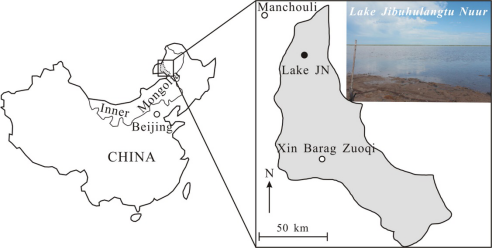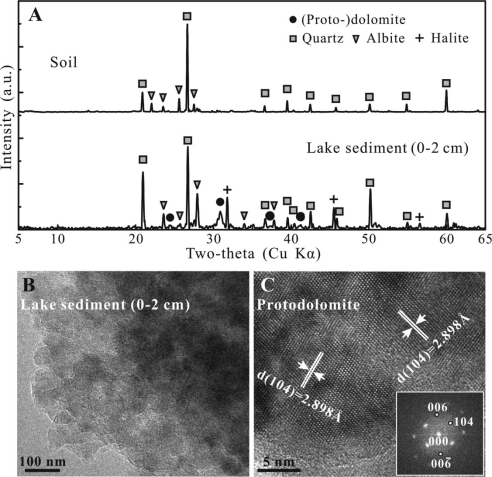“The Catalytic Role of Planktonic Aerobic Heterotrophic Bacteria in Protodolomite Formation: Results from Lake Jibuhulangtu Nuur, Inner Mongolia, China” is published in Geochimica et Cosmochimica Acta (Volume 263, 15 October 2019, Pages 31-49). It is an achievement of Prof. WANG Hongmei and Associate Professor LIU Deng from the School of Environmental Studies. The first affiliation of the paper is the State Key Laboratory of Biogeology and Environmental Geology. The first author is LIU; WANG and LIU are the corresponding authors.
Dolomite nucleation and subsequent crystallization are kinetically-controlled processes. Modern dolomite-forming environments provide clues to the trigger factors that facilitate dolomite formation under Earth surface conditions. It has been documented that certain types of benthic microorganisms promoted the precipitation of protodolomite from sediment pore waters. As protodolomite is thought to be a possible precursor of sedimentary ordered dolomite, microbial mediation has thus been suggested as one interpretation of the occurrence of dolomite in modern sediments. To date, however, it is still unclear whether planktonic microorganisms could directly initiate protodolomite crystallization in the upper water column of present dolomite depositing environments. In this study, we report on the occurrence of authigenic protodolomite in the upmost sediments of a high-sulfate, Chinese inland saline lake (Lake Jibuhulangtu Nuur). This lake was therefore considered to be a natural laboratory to test the catalytic effect of planktonic aerobic heterotrophic bacteria on protodolomite formation. Laboratory mineralization experiments were conducted in a liquid medium that mimicked the ion concentrations and pH condition of lake surface water. The incubation experiments showed that aragonite formed in the abiotic systems, while protodolomite predominantly occurred in the bioreactors using either an enrichment culture or pure isolates of aerobic heterotrophic and halophilic bacteria from lake water. The resulting microbially-induced protodolomite crystals displayed spherical morphology and had MgCO3 composition ranging from 42.7 mol% to 47.1 mol%. These protodolomite spherulites were formed by aggregation of randomly-distributed nano-crystals. Compared to synthetic abiotic protodolomite, microbially-induced protodolomite contained considerable amounts of organic matter, which might occur as intracrystalline inclusion or was located between nano-crystals of protodolomite spherulite. Our results support the emerging view that dissolved sulfate is not an inhibitor for the formation of low-temperature (proto-)dolomite. The presence of organic matter intimately associated with dolomite crystals may serve as a hallmark indicative of a biotically induced origin for some types of dolomite.

Fig. 1. Geographical location of Lake Jibuhuangtu Nuur (JN). The right inset shows a view from the south side of this lake.

Fig. 2. (A) Mineralogical composition of surrounding soil and upmost sediment of Lake Jibuhuangtu Nuur; (B) TEM image of protodolomite particles; (C) HRTEM image showing the occurrence of 2.898 Å lattice fringes, corresponding to d-spacing of (104). The inset FFT pattern with indexation as protodolomite does not show the super-lattice reflections.

Fig. 3. SEM photographs and EDS compositions of major mineral particles occurring in the upmost sediments of Lake Jibuhuangtu Nuur. (A) The large-size detrital albite; (B) An enlarged view of the square area of A showing spheroidal protodolomites on the surface of albite. The Na, Al and Si signals in EDS spectrum of protodolomite came from surrounding albite and the Pt peaks were due to sample coating.
Full Text: https://doi.org/10.1016/j.gca.2019.07.056